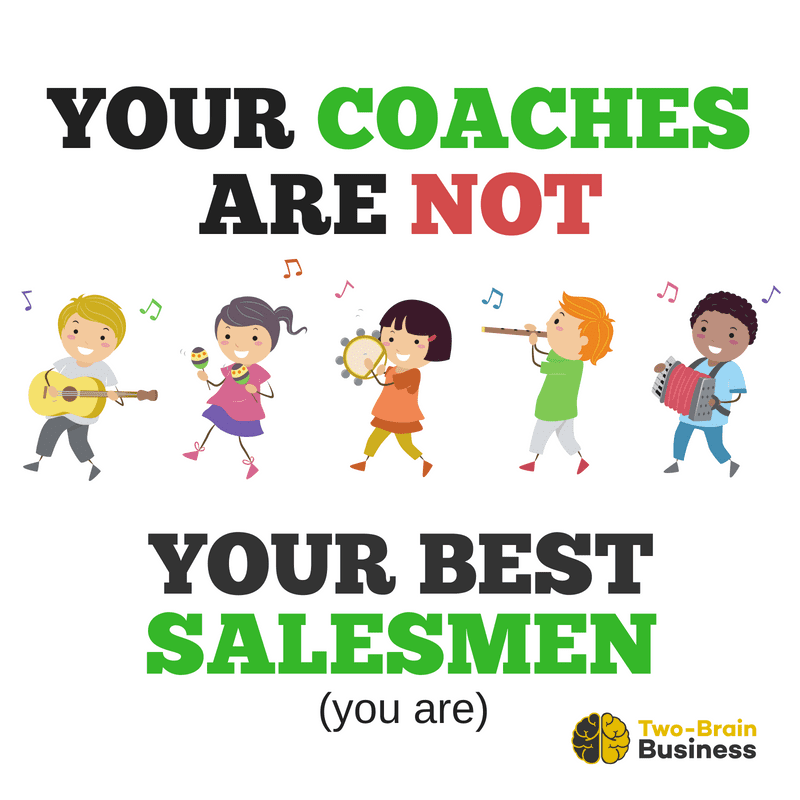“If I pay them more, they’ll act differently and that will bring people in.”
“If I give them a commission, they’ll go bring people in.”
“If I give them a percentage of PT revenue, they’ll be motivated to keep people around longer.”
“If I give them a percentage of the gym, they’ll have skin in the game and we’ll make more money”
No.
None of that will happen.
The last one was a popular myth in 2008 but was widely discarded by 2010 (although some owners took such a bad hit from the idea that they’re still doing the “walk of shame” in 2018).
Many gym owners believe these statements, because they wish they were true. The owner doesn’t want to feel like a salesperson or accept responsibility for bringing in new members. So they abdicate that responsibility—and happily.
“Well, I don’t know how to do it…but if I pay my COACHES to do it, it’s their fault—not mine!”
Who will teach the coaches how to “bring people in”? Because it’s not a matter of incentive—no one has more incentive than the box owner.
Let’s deal with the myths individually:
1. “I want to pay my coaches a bit more per class so they’ll act more professionally.”
You can insert “take out the garbage” or “call missing clients” or “make better warmups” at the end of that sentence. Here’s the thing: If an extra $5 per class is what they need to “flip the switch,” then you have a staffing problem. Their performance and their pay are separate issues. Imagine a baseball player says, “I’ll only hit 25 home runs this year unless you pay me more.” That doesn’t happen because a true professional negotiates off the field and performs at the best level on the field no matter what.
2. “If I pay them a commission for new athletes they bring in—they’ll bring people in!”
First, new athletes aren’t going to meet your coaches for the first time and then follow them to your doorstep. They’re going to hear about you, read your site, bump into your coach, recognize their T-shirt and ask a question. Maybe the coach opened the pickle jar, but you definitely loosened it.
Or maybe they’ve never heard of CrossFit and meet your coach at a baseball game. Then they go on your website, click through your intake process, pay through your bank—you did all the hard work.
Third, if the coach will start trying harder to recruit leads for commission, then what’s stopping them from doing that now? Why are they holding back? If they really believe in their service, they should be doing it for passion anyway.
Finally, paying them to recruit doesn’t mean they know HOW to recruit. Motivation isn’t a replacement for skill.
We don’t pay a bonus or a commission to gyms who refer other gyms to Two-Brain. We don’t have to.
3. “If I pay them a percentage of an athlete’s membership, the coach will be incentivized to keep the athlete around longer.”
Paying a commission doesn’t mean a coach knows how to retain an athlete. Some coaches might be motivated to do a little extra work—if they know what to do—but not more so than coaches who actually care if their athletes show up or not.
Worse, if you have two primary coaches and one does phone follow-ups, birthday cards and goal reviews but the other doesn’t, guess which determines your retention rate? The worst one, not the best.
4. “If I give them a percentage of the gym…”
We don’t need to go there. Ask the owners who fell for that one in 2008—if you can find them in their new careers.
Problem Solving
Here’s how to solve your sales problem:
1. Deliver an excellent experience. An EXCELLENT one, EVERY TIME. Most readers are doing that (woohoo!) but some think they are—and they really aren’t. Hint: an excellent gym experience has nothing to do with your whiskey bar or couches or dog-petting policy.
2. Fix your retention by putting it in the hands of ONE PERSON who’s trained and focused on keeping people in your gym. We call that person our “Joy Person” or client success manager (CSM).
3. Learn the “Help First” strategy to selling. Start doing goal reviews with your best clients. Ask how you can help their friends with [specific problem here].
4. Love your list. I love you guys—my readers—and that’s why I’m compelled to write this stuff. Believe me, I’m putting off an exciting bike ride to write this right now, because I feel I HAVE TO. Email your list almost every day. Give them the secrets. Don’t hold back your care. Pretend you’re coaching them already.
5. Get good at marketing. We produce lots of free content on that, and we teach our clients exactly how to do it.
If you own a business, sales is your responsibility. You might wish it were otherwise. That doesn’t change your responsibility, or the facts: your coaches aren’t salespeople. You are.
(Want more? Read “Who Sells?” here.)

